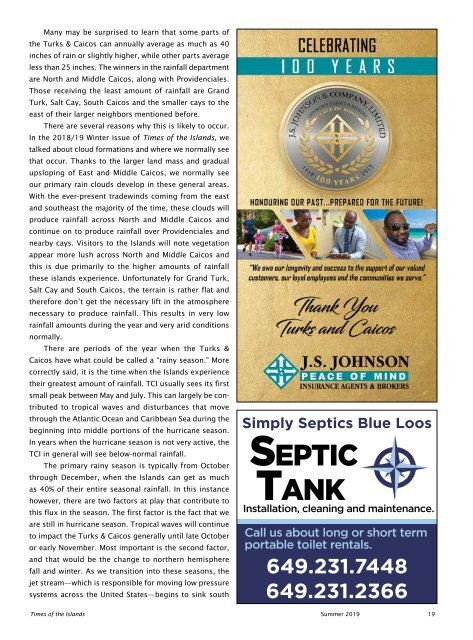Times of the Islands Summer 2019
Presents the "soul of the Turks & Caicos Islands" with in-depth features about local people, culture, history, environment, businesses, resorts, restaurants and activities.
Presents the "soul of the Turks & Caicos Islands" with in-depth features about local people, culture, history, environment, businesses, resorts, restaurants and activities.
You also want an ePaper? Increase the reach of your titles
YUMPU automatically turns print PDFs into web optimized ePapers that Google loves.
Many may be surprised to learn that some parts <strong>of</strong><br />
<strong>the</strong> Turks & Caicos can annually average as much as 40<br />
inches <strong>of</strong> rain or slightly higher, while o<strong>the</strong>r parts average<br />
less than 25 inches. The winners in <strong>the</strong> rainfall department<br />
are North and Middle Caicos, along with Providenciales.<br />
Those receiving <strong>the</strong> least amount <strong>of</strong> rainfall are Grand<br />
Turk, Salt Cay, South Caicos and <strong>the</strong> smaller cays to <strong>the</strong><br />
east <strong>of</strong> <strong>the</strong>ir larger neighbors mentioned before.<br />
There are several reasons why this is likely to occur.<br />
In <strong>the</strong> 2018/19 Winter issue <strong>of</strong> <strong>Times</strong> <strong>of</strong> <strong>the</strong> <strong>Islands</strong>, we<br />
talked about cloud formations and where we normally see<br />
that occur. Thanks to <strong>the</strong> larger land mass and gradual<br />
upsloping <strong>of</strong> East and Middle Caicos, we normally see<br />
our primary rain clouds develop in <strong>the</strong>se general areas.<br />
With <strong>the</strong> ever-present tradewinds coming from <strong>the</strong> east<br />
and sou<strong>the</strong>ast <strong>the</strong> majority <strong>of</strong> <strong>the</strong> time, <strong>the</strong>se clouds will<br />
produce rainfall across North and Middle Caicos and<br />
continue on to produce rainfall over Providenciales and<br />
nearby cays. Visitors to <strong>the</strong> <strong>Islands</strong> will note vegetation<br />
appear more lush across North and Middle Caicos and<br />
this is due primarily to <strong>the</strong> higher amounts <strong>of</strong> rainfall<br />
<strong>the</strong>se islands experience. Unfortunately for Grand Turk,<br />
Salt Cay and South Caicos, <strong>the</strong> terrain is ra<strong>the</strong>r flat and<br />
<strong>the</strong>refore don’t get <strong>the</strong> necessary lift in <strong>the</strong> atmosphere<br />
necessary to produce rainfall. This results in very low<br />
rainfall amounts during <strong>the</strong> year and very arid conditions<br />
normally.<br />
There are periods <strong>of</strong> <strong>the</strong> year when <strong>the</strong> Turks &<br />
Caicos have what could be called a “rainy season.” More<br />
correctly said, it is <strong>the</strong> time when <strong>the</strong> <strong>Islands</strong> experience<br />
<strong>the</strong>ir greatest amount <strong>of</strong> rainfall. TCI usually sees its first<br />
small peak between May and July. This can largely be contributed<br />
to tropical waves and disturbances that move<br />
through <strong>the</strong> Atlantic Ocean and Caribbean Sea during <strong>the</strong><br />
beginning into middle portions <strong>of</strong> <strong>the</strong> hurricane season.<br />
In years when <strong>the</strong> hurricane season is not very active, <strong>the</strong><br />
TCI in general will see below-normal rainfall.<br />
The primary rainy season is typically from October<br />
through December, when <strong>the</strong> <strong>Islands</strong> can get as much<br />
as 40% <strong>of</strong> <strong>the</strong>ir entire seasonal rainfall. In this instance<br />
however, <strong>the</strong>re are two factors at play that contribute to<br />
this flux in <strong>the</strong> season. The first factor is <strong>the</strong> fact that we<br />
are still in hurricane season. Tropical waves will continue<br />
to impact <strong>the</strong> Turks & Caicos generally until late October<br />
or early November. Most important is <strong>the</strong> second factor,<br />
and that would be <strong>the</strong> change to nor<strong>the</strong>rn hemisphere<br />
fall and winter. As we transition into <strong>the</strong>se seasons, <strong>the</strong><br />
jet stream—which is responsible for moving low pressure<br />
systems across <strong>the</strong> United States—begins to sink south<br />
Simply Septics Blue Loos<br />
SEPTIC<br />
TANK<br />
Installation, cleaning and maintenance.<br />
Call us about long or short term<br />
portable toilet rentals.<br />
649.231.7448<br />
649.231.2366<br />
<strong>Times</strong> <strong>of</strong> <strong>the</strong> <strong>Islands</strong> <strong>Summer</strong> <strong>2019</strong> 19

















